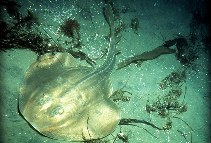| Family: |
Platyrhinidae (Fanrays) |
| Max. size: |
91 cm TL (male/unsexed) |
| Environment: |
demersal; marine; depth range 0 - 137 m |
| Distribution: |
Eastern Pacific: San Francisco, USA to Baja California, Mexico. |
| Diagnosis: |
|
| Biology: |
Inhabits fine sand to mud bottom, often near kelp beds and sometimes abundant on mud flats of coastal bays. Often buries itself in bottom sediments. Ranges from the intertidal zone to 50 m depth (Ref. 12951). Solitary or in small groups, gathers in shallow bays, lagoons, and off beaches (Ref. 12951, Ref. 114953). Feeds on small sand-dwelling crustaceans, worms and mollusks. Ovoviviparous (Ref. 50449), with 1 to 15 pups in a litter (Ref. 48844), mainly in August (Ref. 114953). Possesses ampullary electroreceptors with a region of maximum sensitivity of 5-15 Hz (Ref. 10011). |
| IUCN Red List Status: |
Least Concern (LC); Date assessed: 07 October 2015 Ref. (130435)
|
| Threat to humans: |
harmless |
Source and more info: www.fishbase.org. For personal, classroom, and other internal use only. Not for publication.
